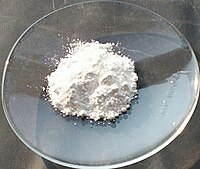
Photo from wikipedia
The sluggish de‐solvation kinetics and uneven Zn2+ transport behavior at the Zn anode are undesirable for commercialization of zinc ion batteries. To address these issues, a periodically alternating electric field… Click to show full abstract
The sluggish de‐solvation kinetics and uneven Zn2+ transport behavior at the Zn anode are undesirable for commercialization of zinc ion batteries. To address these issues, a periodically alternating electric field is introduced on the Zn anode by constructing a laponite nano‐clay layer with unique electric field separation properties. This layer exhibits negative and positive electric fields together in the same space but in different directions (negative electric field in the normal direction while the positive electric field is in the radial direction); thus, achieving both homogeneous Zn2+ transport and an effective de‐solvation effect. The laponite film (LAP@Zn) as a multifunctional artificial layer can induce Zn2+ nucleation for preferential orientation growth of Zn along the (002) planes, thereby suppressing dendrite growth on the Zn anode. Consequently, the LAP@Zn symmetric cells exhibit an ultralow overpotential (12 mV) and cycle smoothly over 1100 h at 0.5 mA cm−2. Even at an ultrahigh current density of 40 mA cm−2, the cell still operates stably for 500 h. More encouragingly, the effectiveness is also convincing in MnO2‐based full cells with excellent rate performance and cycle stability. The periodically alternating electric field strategy provides an effective path toward high‐performance and dendrite‐free Zn‐based storage systems.
Journal Title: Advanced Energy Materials
Year Published: 2023
Link to full text (if available)
Share on Social Media: Sign Up to like & get
recommendations!